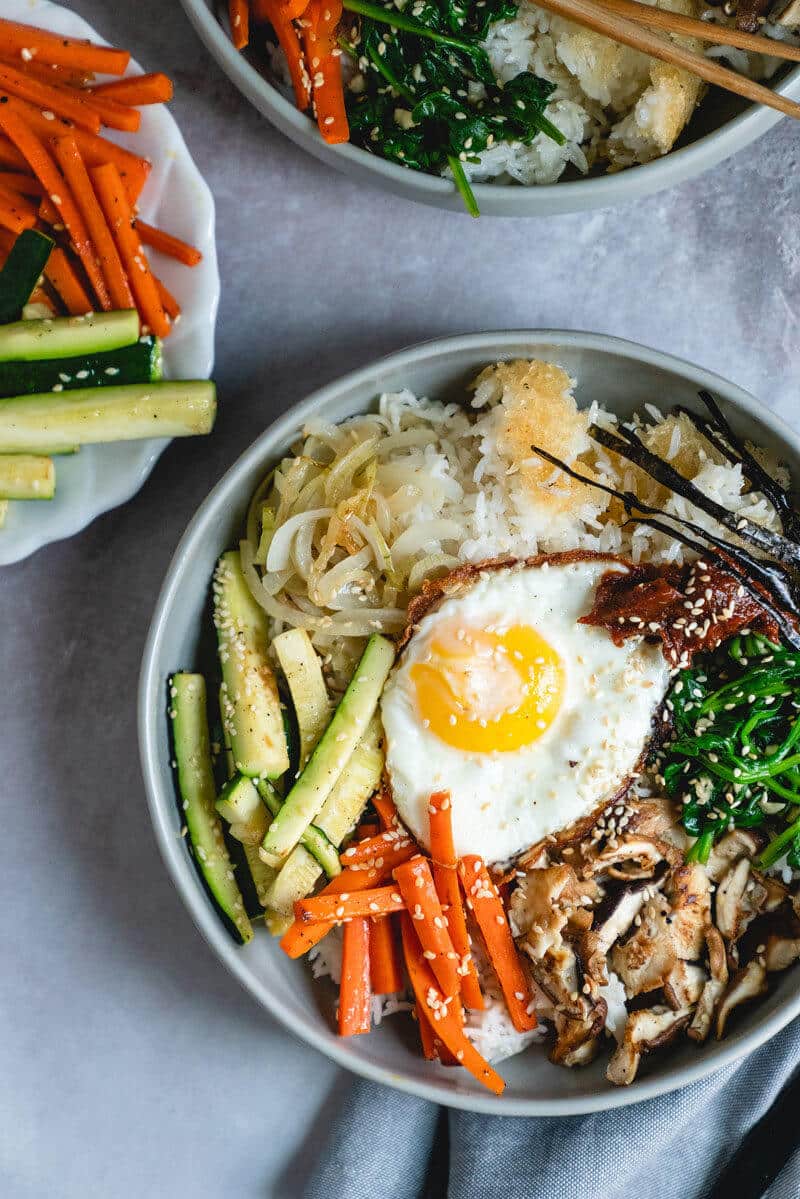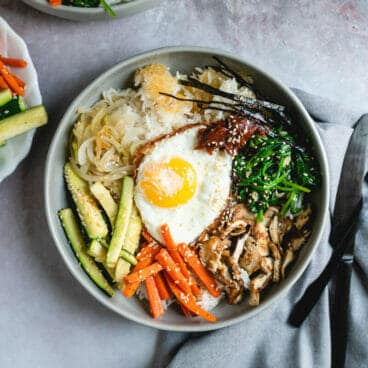This recipe was reprinted with permission from A Common Table by Cynthia Chen McTernan. “If I ever had to choose one meal to eat for the rest of my life, bibimbap would be it.” That’s Cynthia Chen McTernan in her new book A Common Table. And we couldn’t agree more. Alex and I first had dolsot bibimbap at a Korean restaurant here in Indianapolis, in steaming hot stone bowls. The combination of savory veggies, dippy egg and crispy rice was out of this world! We’ve been hooked ever since. Want to learn how to make bibimbap at home? Keep on reading.
What is bibimbap?
Bibimbap is a Korean rice dish: it’s a bowl of warm white rice topped seasoned vegetables. Sounds basic, until you add the spicy gochujang, Korean chili pepper paste, and a fried egg. The best part: you stir the dish together just before eating it! This melds together all the zingy pickled and fermented flavors from the vegetables with the creamy egg yolk. It’s truly one of the most magical experiences. Once you’ve had it once, you’ll be singing its praises.
Then, what’s dolsot bibimbap?
So, what’s dolsot bibimbap? If you order bibimbap “dolsot” style, the dolsot is a hot stone bowl that the bibimbap is served it. The dolsot makes the rice crispy, and takes the entire dish to a whole new level. Our tip for you: if dolsot bibimbap is an option, always order the dolsot version! You won’t be disappointed.
How to make bibimbap: some tips
Bibimbap is the ultimate bowl meal! Because there are so many components, it takes a bit of time to prepare. Make sure to allow at least 1 hour to make bibimbap. You’ll find the time is absolutely worth it, though, because the meld of textures and flavors is simply mind blowing. Here are the major components to make for bibimbap:
Make the rice. White short grain rice is most traditional. Start it and get to work on the rest of the meal. Saute each veggie separately. In the recipe below, you’ll find Cynthia’s simple method for seasoning each with salt and sesame seeds. You can use lots of different veggies, but we prefer the mix she chose. Spinach, shiitake mushrooms, carrots, zucchini and onion are perfection. Make the gochujang sauce. The sauce here is what takes it over the top! It takes just a few minutes to whip up. Fry the rice (optional). Cooking the rice in a cast iron skillet crisps up the bottom and makes it into dolsot bibimbap! Fry the eggs. Right before serving, fry the eggs.
This recipe is incredible! It was so delicious that we immediately made it again for a dinner party. It’s great for entertaining since it’s so customizable. We made this recipe as a vegetarian bibimbap, but the recipe in the book also includes beef bulgogi.
Make dolsot bibimbap: with a cast iron skillet!
Now, if you’re looking to take your bibimbap over the top…make it as dolsot bibimbap! Alex and I assumed we’d have to have a dolsot pan to make dolsot bibimbap at home. Wrong! With Cynthia’s recipe from A Common Table, you can use a cast iron skillet to make the rice crispy! This was game changing for us. It takes about 15 minutes to make the bottom golden and crispy, but it’s absolutely worth it.
Gochujang is a must.
Make sure to find gochujang at your grocery! It’s absolutely necessary to get that signature flavor in the gochujang sauce, which is used to flavor the entire dish. Cynthia’s recipe for gochujang sauce includes gochujang, honey, soy, and toasted sesame seeds. Making the gochujang sauce makes it easier to drizzle over the entire bowl. To shortcut some time you could simply add a dollop of gochujang itself: but that way it’s mostly spicy and misses the savory and sweet components.
Q&A with the author: A Common Table
Cynthia Chen is the author behind the food blog Two Red Bowls, where she shares recipes and life as a lawyer and mama. Her new cookbook, A Common Table, is a work of art. Her photos elegantly capture the inventive food, and her recipes? Well, let’s just say this dolsot bibimbap quickly rose to a fan favorite in our house! Here’s an exclusive Q&A with Cynthia about the book!
Your book is called A Common Table: what does that mean?
Cynthia: At its heart the book is a representation of my little family and the things that make us who we are. So the “Common Table” is an intersection between my Chinese background and my childhood in the South, my husband’s Korean-Irish heritage and his childhood in Hawaii, and the places we’ve been since we met and began a family together. I wanted to put together a collection of our staples and favorite dishes from each of these cuisines, but also something that shows how they have more in common than first appears.
A description of your book says that “the food we eat is rarely the product of one culture or moment, but is richly interwoven.” What’s an example of this?
Cynthia: One dish that I find that has a complex and interesting background is shakshuka. Not only are there are iterations all across the Middle East, there’s its Italian cousin, eggs in purgatory (which I play with a bit in the book!). The same basic combination crops up in other places, too, like in huevos rancheros and even in Chinese scrambled eggs and tomatoes. It is crazy to think that when I sit down at a restaurant and order a dish like shakshuka, what arrives before me is something that often has such a storied history that I can’t begin to comprehend. And it also has something in common with other cultures it didn’t even come from.
You mention if you could eat one food forever it would be dolsot bibimbap. What makes dolsot bibimbap so special?
Cynthia: I have really fond memories of bibimbap because it’s one of the first dishes my mother-in-law taught me how to make when I met my husband. But really I just love that I can never be bored with it. It’s so balanced–it has all sorts of veggies, a grain, a protein, but all kinds of textures and flavors, too. There’s sweetness from the carrots and onions and the bulgogi marinade, savoriness from the beef and egg and nori, that smoky-sweet spice from the gochujang and the crunch if you make it dolsot-style. (Plus, I love that it’s pretty much made for a party where you can mix and match what you put in!) Thank you Cynthia, for sharing the recipes from your shared cultures with the world!
Get the book
Order A Common Table by Cynthia Chen McTernan here!
This dolsot bibimbap recipe is…
Vegetarian and gluten free.
More dinner party recipes
This dolsot bibimbap a delicious vegetarian recipe that’s perfect for a dinner party! Here are a few more dinner party recipes on A Couple Cooks: No reviews
4 to 6 tablespoons vegetable oil (we used grapeseed) 2 cups julienned carrots (about 4 medium carrots) 2 cups julienned zucchini (2 to 4 zucchini) 2 cups thinly sliced onions (1 to 2 onions) 2 cups thinly sliced shiitake mushrooms Salt and black pepper, to taste 1 teaspoon soy sauce, or more to taste 3 to 4 teaspoons toasted sesame seeds, divided 5 to 6 cups packed torn spinach leaves 1 tablespoon minced garlic 2 to 3 cloves) 2 to 4 tablespoons sesame oil, divided 8 to 10 cups cooked white short-grain rice (try our Instant Pot method or Stovetop Method) 4 to 6 large eggs (1 per person) Shredded roasted seaweed (nori), for serving Gochujang or gochujang sauce, for serving
For the gochujang sauce (optional)
½ cup gochujang 2 tablespoons sesame oil 2 tablespoons soy sauce 2 tablespoons honey 1 tablespoon toasted sesame seeds
Italian Calzones Lentil Stuffed Sweet Potatoes Vegetarian Shepherd’s Pie Our Best Vegan Pizza Maki Sushi Recipe Homemade Ricotta Gnocchi Recipe Best Vegetarian Meatloaf Moroccan Cauliflower Soup Thai Salad with Peanut Sauce Dressing Incredible Spaghetti Squash Pad Thai




